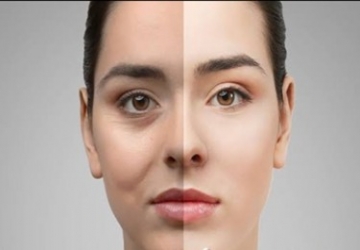
• First: The mid-face lift operation:
Sometimes, with the loss of skin elasticity, we notice the drooping of the cheeks on both sides of the face due to gravity and the loss of nutrients necessary for the freshness of the skin, the lack of collagen and elastin formation elements necessary for skin elasticity, and exposure to aging factors that are often overlooked. The most important of these is constant exposure to sunlight without using sunscreen or not taking antioxidants, whether they are available in foods or some medicinal supplements. As a result of drooping the cheeks, the eyelids droop with them, leading to signs of aging and narrowing of the eyes.
• Second: The process of correcting the curvature of the eyelid:
This method is widespread in East Asia, where it is also called the Asian eyelid correction. This process aims to remove the excess layers of skin surrounding the eyelid that appear as a secondary or extra eyelid, which ultimately leads to a swelling of the upper eyelid of the eye Thus narrow the eyes.
• Third: The process of enlarging the eyes using Botox and Filler:
During laughing or frowning, the muscles around the eye contract, tighten the skin and show wrinkles in and around the corners of the eye, which ultimately leads to the narrowing of the eye’s orbit and its small appearance. Botox is injected in small doses into the muscles around the eye. Botox works by blocking the conduction of nerve signals within the muscles, thus preventing their contraction and the appearance of wrinkles. Botox lasts 3 to 6 months, and it can be injected again to maintain the final eye shape.
As for the injection of filler, it is often used in the lower eye areas, it helps to fill in these areas by injecting some natural materials such as fat cells or collagen, including industrial materials such as hyaluronic acid or polymers (Restylane). The action of the filler lasts from 6 months to a year, depending on the type and cost to be used, and it is also possible to re-inject to maintain the achieved result.